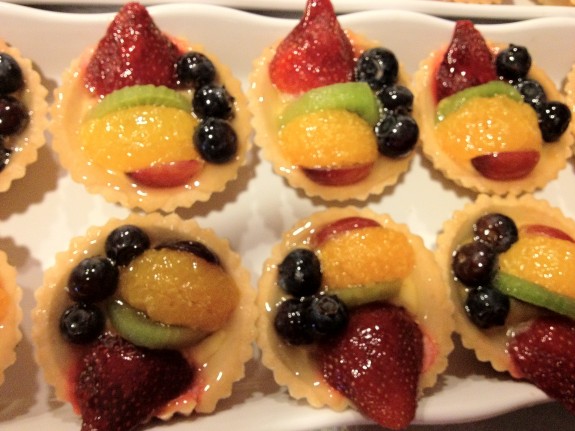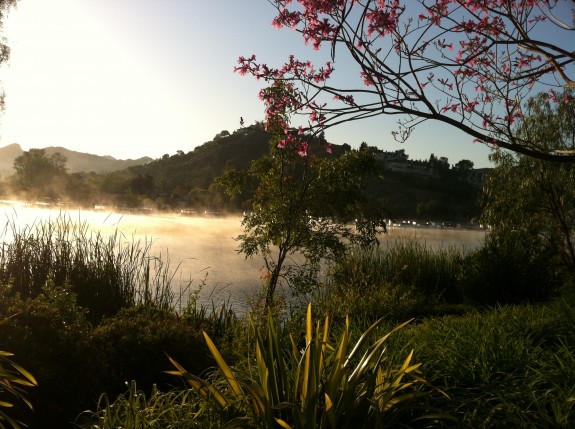Seafood Risks and Benefits
- At June 04, 2012
- By Katherine
- In Articles, News
 0
0
Seafood is a source of potent omega-3-fatty acids, a type of polyunsaturated fat important for your health, particularly your heart and brain. To get these benefits, experts recommend you get at least 4 to 11 grams of omega-3-fatty acids weekly (1.1 grams/day for women, 1.6 grams/day for men). Cold water fish contain the highest levels.
It’s ideal to eat fish high in omega-3-fatty acids, yet low in mercury.
Mercury is an environmental pollutant which seeps into the earth’s waters and into our seafood. Nearly all fish and shellfish contain traces of mercury, with some containing more than others, according to the Food and Drug Administration. And with the fear of mercury poisoning from fish, many are confused about what and how much to eat.
Ironically, the most vulnerable to mercury’s hazards – children and pregnant or nursing women – have the highest need for the nutrients in seafood.
Some guidelines:
1) DON’T eat shark, swordfish, king mackerel or tilefish,
2) DO eat up to 12 ounces of a variety of seafood low in mercury:
- Five of the most commonly eaten fish which are low in mercury are shrimp, canned light tuna, salmon, pollock, and catfish
- Albacore tuna has more mercury than light tuna, so limit it to 6 ounces per week
3) CHECK local advisories about fish caught in local lakes, rivers and coastal areas
4) Low Mercury, High Omega-3-Fatty Acid Seafood: Salmon, Herring, Sardines, Anchovies
Fun with Fruit – Seasonal Chocolate Dipped Fruit & Popsicles
- At May 31, 2012
- By Katherine
- In News, Recipes
 0
0
This is my favorite time of year. There’s an abundance of locally picked strawberries and cherries at the Farmers Markets. Very soon there will be: raspberries, blueberries, plums, apricots, and more… All lend themselves beautifully to being dipped in dark chocolate or pureed and made into popsicles or into an adult Italian Ice (Granita). My recipes:
Dark Chocolate Dipped Strawberries or ANY Seasonal Fruits
Strawberry (or any Seasonal Fruit) Granita
Pure Strawberry – or any Seasonal Fruit – Popsicles
Simply puree the fruit (add a tiny bit of sweetener or sweet juice, if you like) and place in popsicle molds! Leave the pureed fruit a little chunky for texture. Add yogurt to make it creamier. Use a variety of fruit to create different colors and flavors.
Memorable Memorial Day Weekend Recipes
- At May 25, 2012
- By Katherine
- In News, Recipes
 0
0
Have a lovely Memorial Day! My suggestions for wonderful dishes for the holiday, using local, seasonal picked-at-peak-ripeness ingredients… What’s at market now and most delicious? Asparagus, strawberries, onions, potatoes, cherry tomatoes… Enjoy!
Starter: Puree of Asparagus Soup with Tarragon
Main Course: Salad of New Potatoes and Asparagus with a Lemony Garlic-Herb Mayonnaise Topped with Poached Salmon
OR
Main Course: Kjerstin’s Curried Chicken Salad with Strawberries, Grapes and Roasted Almonds
Dessert: Strawberry Granita
7 So Called “Bad” Foods That Are Actually Good For You
- At May 23, 2012
- By Katherine
- In Articles, News
 5
5
Are you shying away from bad foods that are actually good for you? With all the hoopla about healthful eating, it’s hard to separate fact from fiction.
As a nutrition consultant, I’ve come to realize there is no shortage of surprises and superstitions in the world of nutrition. As a follow-up to my recent Washington Post article, “5 So-Called Health Foods You Should Avoid,” I thought it would be fun to give you reasons to enjoy some of your favorite so-called “bad” foods that could actually be good for you, originally published in The Washington Post…
Gluten and Wheat
They are “the most demonized ingredients beyond high fructose corn syrup and hydrogenated oil,” said Melissa Abbott, culinary director at the Hartman Group, a company specializing in consumer research.
Yet decades of studies have found that gluten-containing foods, such as whole wheat, rye and barley, are vital for good health, and are associated with a reduced risk of diabetes, heart disease, cancer and excess weight.
“Wheat is a good source of fiber, vitamins and minerals,” said Joanne Slavin, nutrition professor at the University of Minnesota. She added that the confusion about gluten, a protein, has caused some people to avoid eating wheat and other grains.
Only about 1 percent of the population – those with celiac disease or wheat allergy – cannot tolerate gluten and must eradicate it from their diet to ease abdominal pain and other symptoms, including the ability to fully absorb vitamins.
One reason wheat-free or gluten-free diets are popular is that people who don’t eat wheat often end up bypassing excess calories in sweets and snack foods. Then they start feeling better, lose weight, and mistakenly attribute their success to gluten or wheat avoidance. Learn more about a gluten free diet and who may benefit from it…
Eggs
Eggs also don’t deserve their bad reputation. In recent decades, their high cholesterol content has been thought to play a role in increasing LDL (“bad”) cholesterol and heart disease risk. But cholesterol in food is a minor factor contributing to high blood cholesterol for most people, and studies have not confirmed a correlation between eggs and increased heart disease risk. The major determinant of LDL (bad) cholesterol is saturated fat, and while eggs are high in cholesterol – 184 milligrams in the yolk – they’re relatively low in saturated fat – about 1.6 grams in the yolk.
Interestingly, some of the biggest egg eaters in the world, the Japanese, have low cholesterol and heart disease rates, in part because they eat a diet low in saturated fat. In contrast, Americans eat eggs alongside sausage, bacon, and buttered toast.
“The amount that one egg a day raises cholesterol in the blood is extremely small,” says Walter Willett, professor of epidemiology and nutrition at Harvard’s School of Public Health. “Elevations in LDL (bad) cholesterol of this small magnitude could easily be countered by other healthy aspects of eggs.” Learn more about eggs…
Potatoes
Potatoes have been blamed for increasing blood glucose levels, insulin resistance, excess weight and Type 2 diabetes. A recent Harvard study that followed large populations and their disease rates linked potato eating with being overweight, blaming it on the blood glucose rise.
But many foods, including whole-wheat bread and whole-grain cereals, cause similar spikes in blood glucose, and are correlated with superior health and lower body weights. How could the higher body weight in the Harvard study be explained? The study lumped all potato products together, including potato chips and french fries, very fattening versions of potatoes usually eaten in large portions alongside hamburgers, hot dogs, and sodas.
“It’s an easy food to attack; but the meal pattern may be the culprit,” said David Baer, a research leader at the Agricultural Research Service of the Department of Agriculture. “Other epidemiological studies have not verified a connection between potatoes and weight gain or any diseases, and no clinical studies have shown a connection.” Learn more about the Harvard study…
Potatoes are a great source of potassium, Vitamin C and fiber that many cultures – Scandinavians, Russians, Irish, and Peruvians – relied on as a nutritious staple for centuries. And they were not fat.
Fruits
People often ask me if fruit is too high in sugar, especially for diabetics. This fear of fruit, I believe, is left over from the Atkins craze, which discouraged eating some fruits on the grounds that they are high in carbohydrates.
Avoiding fruit could actually damage your health. Study after study over many decades shows that eating fruit can reduce the risk of some cancers, heart disease, blood pressure and fruit. Lean how fruit reduces diabetes risk…
Fruit is high in water and fiber, which help you feel full with fewer calories, one reason why eating it is correlated with lower body weight. Even though they contain simple sugars, most fruits have a relatively low glycemic index. That is, when you eat fruit, your blood sugar raises only moderately, especially when compared with refined sugar or flour products.
Several health organizations, including the U.S. Dietary Guidelines, the National Cancer Institute, and the American Heart Association, recommend Americans eat at least five cups of fruits and vegetables a day because of their superior health benefits.
Soy
Though popular for centuries in many Asian cuisines, soy is sometimes seen as dangerous after studies found elevated rates of breast cancer among rats when they were fed a concentrated soy derivative. But studies looking at whole soy foods in humans have not found a connection. In fact, the reverse may be true.
Soy, “when consumed in childhood or adolescence may make breast tissue less vulnerable to cancer development later in life and probably has no effect on breast cancer risk when consumption begins in adulthood,” said Karen Collins, registered dietitian and nutrition adviser with the American Institute for Cancer Research.
Actually, Collins said, the evidence is so strong for protection against heart disease that the FDA allowed a health claim for labels on soy food products.
Alcohol
Alcohol is feared because of the potential for abuse and alcoholism and complications such as liver disease, which are valid concerns.
But decades’ worth of research shows that moderate alcohol consumption “can reduce deaths from most causes, particularly heart disease, and it raises HDL (good) cholesterol,” the USDA’s David Baer said.
Wine may have additional benefits because its grapes are filled with nutrients called polyphenols, which reduce blood-clotting, inflammation and oxidation.
The key is to drink alcohol moderately and with meals. What’s moderation? One serving daily for women and two servings for men, with a serving being 5 ounces of wine, 12 ounces of beer or 1.5 ounces of spirits. Learn more about wine…
Fried Foods
While it’s true that frying food usually increases its caloric content, that doesn’t necessarily make it unhealthful.
As long as food is fried in healthful oil instead of butter, shortening, or trans fat, and it’s eaten in moderation, it isn’t less healthy. In fact, fat-soluble vitamins A, D, E, and K, and heart-healthy, cancer-preventive carotenoids such as beta-carotene (e.g., carrots, sweet potatoes), lycopene (e.g., tomatoes) and lutein/zeaxanthin (deep-green leafy vegetables such as spinach and kale), need fat in order to be absorbed by the body.
“The consumption of certain fats, such as saturated fatty acids and trans fatty acids [fats that are solid at room temperature],is associated with an . . . increased risk of cardiovascular disease. On the other hand, the unsaturated fats, monounsaturated fatty acids and polyunsaturated fatty acids [canola, safflower and olive oils] have significant metabolic benefits and are health promoting,” said the 2010 U.S. Dietary Guidelines Advisory Committee. Learn more about healthy fats…
Read my Washington Post “Local Living” cover story 24 May 2012
and
Zucchini Ribbons with Fresh Lemon Vinaigrette
- At May 15, 2012
- By Katherine
- In News, Recipes
 0
0
Excerpted from “Diet Simple Farm to Table Recipes: 50 New Reasons to Cook in Season!“
Oldways, A nonprofit food and nutrition education organization, with a mission to guide people to good health through heritage, asked me to provide a recipe for their website… Since Oldways promotes the Mediterranean way of eating and I’m a huge fan, I said YES! Out of the many recipes I supplied them, they chose “Zucchini Ribbons with Fresh Lemon Vinaigrette” for their website.
Serves 6 – 8
Ingredients:
Katherine’s Favorite Vinaigrette:
Juice of 2 lemons (about 4 Tablespoons)
4 Tablespoons Extra Virgin Olive Oil
1 teaspoon coarse sea salt or Kosher salt
1 teaspoon freshly ground pepper
1 Tablespoon of fresh Basil, shredded, or fresh herb of your choice (optional)
The Vegetables:
4 or 5 small zucchini, green and/or yellow, with peel
1 onion, sliced very thinly
1 small red pepper, sliced thinly
Directions:
Prepare the vinaigrette by whisking all ingredients together in a large salad bowl.
Slice the onion and red pepper thinly, place in the vinaigrette and toss.
Slice the zucchini into ribbons, using a vegetable peeler and slicing vertically from end to end. This will make very thin slices. You may also use a cheese slicer or mandoline. Add the zucchini, toss and serve immediately, or chill and serve later.
The entire recipe contains 644 calories. Divided by 8 servings is 81 calories per serving.
This recipe was adapted from the Palmer-Sadasiv family’s “Zucchini Ribbon Salad,” from “Let’s Eat In! Family-Tested Recipes from Around the World & Around Your Block.”
Eating to Save the Planet
- At May 14, 2012
- By Katherine
- In Articles, News
 3
3
Katherine explaining “Farmers Markets: Good For You, Good For The Environment” Watch on CNN
For those of you who want to make a contribution toward saving the planet, you may want to consider changing what you eat. One simple way to do that? Buy locally and seasonally at your Farmers Market.
What you eat profoundly affects not only your health, but the environment, too. This is important news because when it comes to environmental issues and halting global warming, many of us feel overwhelmed and helpless. So it’s amazing that something as simple as making better food choices can reduce global warming by lowering greenhouse gases, saving land, and conserving diminishing water and energy supplies.
Your protein choice will make the most significant difference on the environment (and your health). Producing meat requires six to seventeen times more land than growing vegetable protein, 26 times more water. And producing vegetables is up to 50 times more energy efficient than meat production, according to a study in the American Journal of Clinical Nutrition.
Eating vegetable protein will also save your health. Decades of research has found that plants contain compounds (phytochemicals) with potent powers of healing. People who eat a plant-based diet are leaner, have less cancer, heart disease and diabetes.
But when eating more fruits and vegetables, it’s important to consider how and where they’re grown. Environmental resource conservation is reduced if food is transported long distances and grown in large industrial farms which specialize in only one or a few foods. Locally, organically produced food saves water, energy and encourages a region’s unique varieties of fruits and vegetables. Heirloom varieties, for example, have been passed down through generations, have natural resistance to pests, disease and are better able to tolerate local conditions without too much exra energy, pesticides or water.
How you can protect the environment through your food choices:
* Buy seasonally and locally at farm stands and farmers’ markets,
* Eat a plant-based diet,
* Reduce meat consumption,
* Use heirloom varieties, whenever possible,
* Buy organic whenever possible.
This article was excerpted from: The Journal of the American Dietetic Association 2007; 107: 1033 – 1043 “Position of the American Dietetic Association: Food and Nutrition Professionals Can Implement Practices to Conserve Natural Resources and Support Ecological Sustainability”
My Daily Westlake Village Walk
- At May 06, 2012
- By Katherine
- In News
 2
2
Visiting my parents in Westlake Village, California is a pleasure. They settled here in the 1980s, and while I’ve never lived here it’s a great place to visit.
This week I’m here to help take care of my mother after knee replacement surgery. She is on my special “Healing Diet” which made a difference for her 5 years ago after hip replacement surgery. So we’re doing it again!
While I’m visiting, every morning I walk the approximately 4 miles around Westlake Lake.
It’s a beautiful way to start each day… and my pedometer reads 9,000 steps!
I’m not completely alone during my walks. Everyone nods with a polite, “Good Morning!”
Lots of cute doggies to admire and pet, too…
Then I spend a little time with a few of Dad’s pals solving the world’s problems…
Dad has friends everywhere…
Healing Nutrition
- At May 06, 2012
- By Katherine
- In Articles, News
 1
1
It’s scary thinking of my mother going through surgery. I’m especially concerned that she maintain her active life here in Westlake Village, California. Mom has tons of friends, she volunteers at the Thousand Oaks Civic Arts Center, and she and Dad even work as Crossing Guards at local elementary schools. They regularly attend concerts at Hollywood Bowl (she LOVES Pink Martini),visit wineries, well, you get the idea. They may be “retired,” but they’re definitely not retired from living life!
To get her back to fighting form as soon as possible, she’s following my special “Healing Diet.” My healing diet worked beautifully after her hip replacement surgery 5 years ago; she healed quickly, and without the weight gain she dreaded. So I’m back again repeating the performance!
What you eat profoundly affects your ability to recover from surgery or heal from any injury. Everyone’s nutritional needs are different, but there are general rules of thumb for maximizing your body’s ability to heal through foods.
Healing Nutrition Principles
Because you’re sick or recovering from an illness or surgery, you are inactive. That means your calorie need is usually quite low (there are exceptions), but to heal properly, your nutrient intake must be high. It’s challenging to keep calories low, yet nutrients high; but it is very do-able, and I have successfully helped many people (including my mother) recover from surgeries and illnesses without weight gain, and even some weight loss – while at the same time – healing quickly and effectively. To do this, concentrate on nutrient-dense, low calorie healing foods, eaten at regular time through the day.
Protein
Protein is one of the most important nutrients in the human body, second only to water. Protein is critical for healing. Immune function is impaired without enough. The antibodies essential to protecting your body against pathogens are made of protein. Protein builds muscle and tissue, broken down after injury or surgery.Without enough protein, your body has no chance to heal.
Certain vulnerable populations, such as the elderly, children, and those who already have compromised immune systems, should be particularly careful to eat enough protein – even more than the recommended dietary allowance – for maximized protection. Your protein needs should be individualized and, to maximize your body’s ability to absorb and use the protein, should be eaten in small amounts through the day. Stick with lean, low calorie protein sources since you’re not active (see examples below). Learn more about protein…
Fats and Oils
The type of fat you eat can improve healing and the effectiveness of your body’s immune response because fat ends up in all of your body’s cell walls. It acts as a cell lubricant, improves flexibility and communication between cells. If the fat you eat is saturated – solid at room temperature – as in butter or animal fat – this decreases cellular flexibility and functioning. Learn more about healthy, healing fats… Eat healthy fats at each meal, but keep your fat intake low, as fats are high in calories, and since you’re inactive, you must keep your calorie intake low.
Berry Bonanza
- At April 29, 2012
- By Katherine
- In Articles, News
 0
0
There are very few foods that match the beautiful color and intense flavor of berries. And, fortunately, these fruits are nutrition superstars.
For many years, most berries were regarded as nutritionally inferior because of their lack of traditional essential nutrients such as vitamins A and C. But that was before scientists recently discovered the presence of large amounts of beneficial phytochemicals (“phyto” is Greek for plant).
Apparently, each berry contains at least 100 nutrients and phytochemicals, the plant compounds with potent powers of healing. Some of the most important phytochemicals in berries are antioxidants, powerful substances believed to reduce inflammation, improve immune function and help prevent heart disease and cancers.
Antioxidants are compounds that absorb oxygen free radicals — molecules that cause oxidation in the body’s cells. Scientists believe that these molecules cause most of the diseases of aging, such as immune system decline, arthritis, heart disease, cancer and neurological impairments affecting cognition and balance. Think of oxidation as being similar to rusting. Or imagine an apple slice turning brown. By simply adding lemon juice, an antioxidant, the apple’s flesh stays fresh and prevents the browning or oxidation.
A similar thing happens in your body. Oxidation is constantly occurring in your cells because of environmental pollutants, smoking, exposure to the sun, heat generated through basic metabolic functioning, unhealthy diets and other factors. It takes a large supply of antioxidants to counter this. Berries have been found to have one of the highest antioxidant scores of all fruits and vegetables.
But there are other good reasons to eat berries. The berry family contains 300 to 400 beneficial, disease-fighting chemicals. The phytochemicals in berries, depending on the type, also stimulate the immune system, reduce inflammation, enhance cancer-fighting enzymes, positively influence hormone metabolism, have antibacterial and antiviral effects and may even reverse some aspects of brain aging.
The most potent berries are the more deeply colored varieties, especially blackberries, blueberries and cranberries, followed by raspberries, strawberries and cherries (not technically a berry, but similar nutritionally) but all more potent than most other fruits. Their color is provided by one of the most powerful phytochemicals, called anthocyanins, which berries synthesize to protect themselves from the elements.
“Anthocyanins play a role in . . . protecting against cancers of the gastrointestinal tract,” says Ronald Prior, nutritionist at the Arkansas Children’s Nutrition Center in Little Rock. “Blackberries have been shown in animals to protect against colon and esophageal cancer.” A preliminary human study found blueberries inhibited blood clotting, a risk factor in cardiovascular disease.
The anthocyanins in berries also may be responsible for improving some aspects of aging, such as memory, motor coordination, balance, vision and even symptoms of Alzheimer’s disease, according to many years of animal studies.
“Blueberries have interesting, surprising qualities,” said Prior. “We’re hoping foods such as blueberries can help prevent Alzheimer’s disease in humans as they do in rats.”
The scientists found similar effects in cranberries, which have additional phytochemicals called tannins. They may be responsible for helping to prevent urinary tract infections, stomach ulcers, gum disease and even ear infections in children. Cranberries are also effective against antibiotic-resistant bacteria — and 20 percent of urinary tract infections are resistant to antibiotics. The tannins work by blocking the disease-causing bacteria and preventing it from adhering to human cell walls.
Resveratrol
New research has found that raspberries, blueberries, cranberries and huckleberries contain a phytochemical called resveratrol, also present in wine, which is thought to help prevent cancer, cardiovascular disease, and is implicated as an important compound in the health benefits of the “French Paradox.”
Strawberries contain large amounts of phytochemicals called ellagitannins, which are also in raspberries and blackberries. Studies at the UCLA Center for Human Nutrition found those berries are capable of inhibiting a number of key steps in the development of cardiovascular disease and may have immense potential for the prevention and treatment of heart disease and stroke. Strawberries are also high in antioxidant Vitamin C and folic acid, important in preventing birth defects.
Most of what scientists know about berries has been determined in animal studies and in labs using cell cultures. But the few human clinical studies are showing promising results. Human studies on berries are limited because they’re very expensive, and as one scientist explained, “You can’t patent a berry!” This means that big pharmaceutical companies are unwilling to foot the research bill. Groups such as blueberry or strawberry growers fund some, but it’s up to Uncle Sam to find out if we can save millions on medications and hospitalizations by simply eating more berries.
Berries are an ideal food. Besides being absolutely delicious and colorful on a plate, they’re loaded with nutrients, vitamins, minerals, fiber, and they’re low in calories. They have maximum flavor and nutrient content when picked at ripeness. Freezing them when ripe or buying ripe frozen berries is a great alternative. But, simply ripening a berry on your kitchen counter will increase its phytochemical content, too.
Berries can be eaten morning, noon or night – whatever your preference. I eat berries every morning on my oatmeal. In the summer, I’ll use any fresh local berry but in the winter, I stick with frozen blueberries.
“Berries are extremely versatile; they fit perfectly with any meal or snack,” says Janie Hibler, author of “The Berry Bible” (William Morrow, 2004). In “The Berry Bible,” Hibler provides a berry encyclopedia and berry recipes ranging from smoothies, drinks, and breads to soups, salads, salsas, main courses, and desserts.
So, what are some ways we can eat berries every day?
“A no-brainer,” she says, “is a berry smoothie for breakfast.” For lunch, she says, throw a handful into your salad. For snacks, carry dried berries and nuts. At dinner, berries go beautifully with meats, grains and main courses.
You will eat more berries if you simply keep them on hand and ready to grab. Get them now when they’re fresh and freeze them yourself. Frozen blueberries are fun snacks for kids to pop in their mouths, like hard candy. You can also make berry popcicles, syrups for pancakes and spritzers.
Berry Coulis
Hibler recommends always having berry purees, or “coulis” on hand. “A sauce rivaled by none,” she says. But they also are great added to drinks, smoothies, yogurts, cereal, you name it. To make a coulis, rinse and drain the berries, process in a food processor. Add a little sugar or even liqueur, if desired. It will keep in your refrigerator for three to four days or be frozen for a month.
Some of my favorite berry recipes:
Spinach and Strawberry Salad with Toasted Almonds and Balsamic Vinaigrette
Katherine’s Spicy Mexican Salsa with Strawberries
Soupe aux Fraises et Rhubarbe (Strawberry Rhubarb Soup)
Kjerstin’s Curried Chicken Salad with Strawberries and Toasted Almonds
Strawberry – or any Berry – Granita
Dark Chocolate-Dipped Strawberries
Originally Published in The Washington Post

![Fish - salmon_chinook_large[1] Illustration by Charlotte Knox](https://katherinetallmadge.com/wp-content/uploads/2012/06/Fish-salmon_chinook_large1-Illustration-by-Charlotte-Knox-e1338816637607.jpg)






















